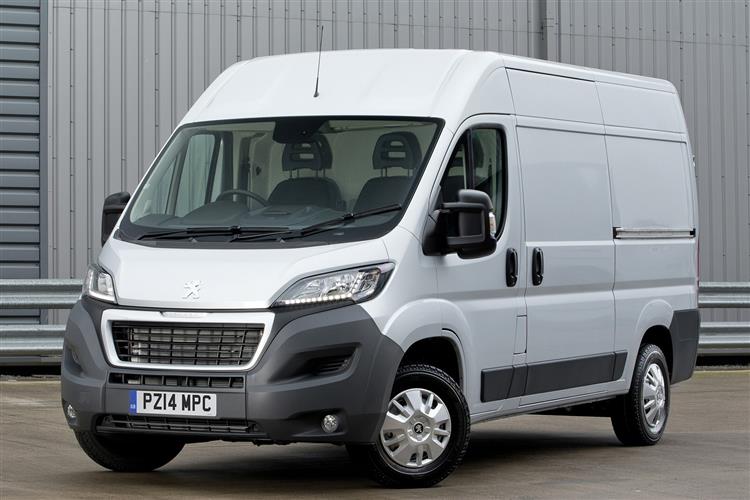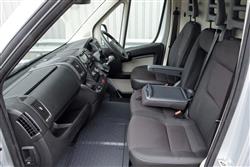This is a sample, showing 30 seconds of each section.
BOXING CLEVER (some text hidden) SECTIONED_new_peugeotboxer_2015
By Jonathan Crouch
Introductionword count: 113
In 2014, Peugeot restyled and revitalised its largest van, the Boxer, the lion brand's clone of its PSA Group cousin, the Citroen Relay. The idea was to give the company's biggest van a fighting chance in the large panel van sector, with strong, sensible design that appealed to careful operators. From launch, no direct rival could significantly better this big LCV's payload or its load-carrying capacity - and few could equal its low costs of operation. Equipment levels were also superior to those of many obvious rivals. In other words, it aimed to score in the areas that really matter to business users. Let's check this 2014-2024-era Boxer out as a used buy.
Modelsword count: 4
Medium-sized van (2.2 diesel/Full-Electric)
Historyword count: 170
If size matters for your business, then only the largest van will do. Something perhaps, like this one, Peugeot's Boxer. This third generation model dates back to 2006 but was substantially updated in mid-2014 to create the facelifted version we're going to look at here. Peugeot has a long history in van production. By 2014, the brand had assembled over 1.8 million LCVs since 1950, nearly a million of which had been Boxer models produced across the three generations on sale since 1994. Throughout that time, this vehicle had its design shared with two other rivals - Fiat's Ducato and Citroen's Relay - the LCVs that from 2014 onwards continued to provide this Boxer's toughest competition. That collaboration continued with this improved design, though only the Citroen model shared the same engines that Peugeot used here. An all-electric E-Boxer model arrived in 2022. The Boxer (and e-Boxer) sold in this form until early 2024, when they were substantially updated. It's the pre-facelift 2014-2024-era versions though, that we concentrate on here.
What You Getword count: 464
The days when panel vans were nondescript clones of one another are thankfully behind us and the Boxer's stubby frontage is certainly distinctive. The headlights and front grille were re-styled for this improved model to create what the brand hoped was an 'expressive, feline and technological' look inspired by the then-current range of Peugeot cars. Inside the cab, the design is less dramatic than that of the exterior but it is thoughtfully executed, featuring a smarter-looking dash and better quality seat trims than Boxer operators had previously been used to. A fresh addition for this improved post-2014-era MK3 model Boxer was a 5-inch dash-mounted touchscreen infotainment display which makes the vehicle feel a bit more modern inside and came as standard, providing original buyers avoided entry-level trim. As well as the usual stereo and Bluetooth elements, this handles features like audio streaming, text-to-speak messaging and satellite navigation. On to practicalities. The junior version of this Boxer is the L1H1 (short wheelbase, low roof) panel van which could be specified in 3.0 and 3.3 tonne gross weights, and has a load space volume of 8.0 m3. Despite this being the smallest van in the range, it still has a load length of 2670mm, an internal load compartment height of 1662mm, a maximum load width of 1870mm and a between-the-wheel arches dimension of 1422mm - wide enough for an 8ft x 4ft sheet to be loaded flat on the floor. Graduate to the medium wheelbase L2 model and you can get both standard and high roof formats, giving respective load volumes of 10m3 and 11.5m3. The Boxer L2 panel van has a load deck length of 3120mm and either an interior load height of 1662mm (H1) or 1932mm (H2). It could also be specified in 3.3, 3.5 and 4.005 tonne gross weight versions. Should you really need some big capacity, the long wheelbase L3 format will be the ticket. In this configuration, the Boxer has a load deck length of 3705mm and an internal load height of 1932mm, which gives a 13 m3 capacity. The largest Boxer panel vans are the 3.5 and 4.005 tonne L4H2 and L4H3 models, which have a load deck length of 4070mm and a 17.0m3 capacity. If you're opting for the all-electric E-Boxer, you'll be pleased to find that its EV powertrain doesn't compromise load volume. That's because the drive system's lithium-ion battery is mounted under the floor between the front and rear axle and so doesn't impinge on the cargo bay. On to running cost efficiency. The 2.2 litre turbo-charged diesel engines offer reasonable fuel economy. The 120hp variant manages up to around 35mpg on the WLTP cycle in regular use, with the 140hp unit much the same. Even the gutsier 165hp powerplant only falls as far as around 31mpg.
To see the full road test text contact us on 0330 0020 227
Pictures (high res disabled)

.jpg)
|
.jpg)
|
.jpg)
| |||
.jpg)
|
.jpg)
|
.jpg)
| |||
.jpg)
|
.jpg)
|
.jpg)
| |||

|
Scoring (subset of scores)
Category: Vans
| Performance | |
| Handling | |
| Comfort | |
| Space | |
| Styling, Build, Value, Equipment, Depreciation, Handling, Insurance and Total scores are available with our full data feed. | |



